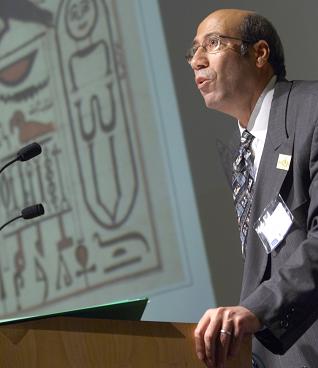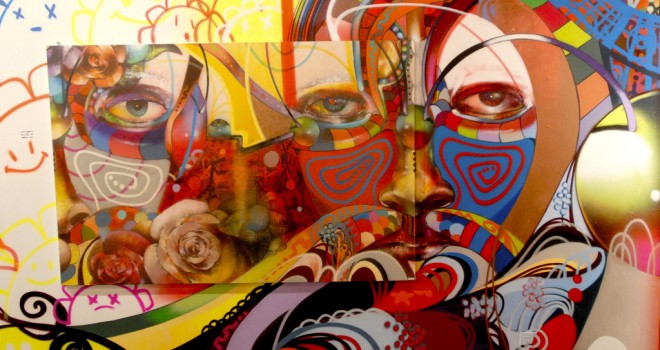
Deciphering Egyptian Hieroglyphs in Muslim Heritage
The article is originally a talk presented at the international conference 1001 Inventions: Discover the Muslim Heritage in our World held at the Museum of Science and Industry in Manchester on the 8th of March 2006, on the occasion of the launch of the exhibition 1001 inventions. The conference proceedings are edited by Dr. Salim Ayduz and Dr. Saleema Kauser.
It is interesting for me as an Egyptologist to notice how the Islamic environment created an atmosphere in which the intended scholar could freely seek knowledge wherever it came from, and in whatever ancient language/culture it may originate, thus giving the incentive to various scholars to dedicate their lives completely to the discovery and the reading of ancient scripts, such as Egyptian and Mesopotamian. Sadly we Egyptologists acknowledge no contribution from Arabic or Muslim authors, mainly because many Egyptologists worldwide are not aware of the relevance of Arabic sources to our discipline. Most Egyptologists have enough on their plates already to contend with, and often we overlook European sources that show clearly that even here in Europe in the 16th and 17th centuries, there was a great deal of interest in medieval Arabic manuscripts that specifically covered Ancient Civilisations and in particular the Ancient Egyptian. Here is the title page of an Arabic book translated in France in 1666, about the Ancient Egyptian monuments, written by an Egyptian scholar called Mourtadi. The very same book was translated into English, and published in London six years later. This is an early case of European Egyptomania as we know it, and it shows the value of these Arabic manuscripts. Most fascinating among these Arabic manuscripts is a work translated into English, published in London in 1806 by an eminent orientalist, Joseph Hammer. The title of this English translation is: “Ancient Alphabets and Hieroglyphic Characters Explained; with an Account of the Egyptian Priests, their Classes, Initiation, and Sacrifices in the Arabic Language by Ahmad Bin Abubekr Bin Wahishih”. Notice the date 1806, that is 16 years before Champollion published his famous letter in which he announced to the world his success in deciphering Egyptian Hieroglyphs. Champollion was a teenager when this book was published here in London. Now, one of our assumptions in Egyptology is that Arabic authors knew nothing of Ancient Egypt, before Muslims conquered Egypt in 641 CE. Sadly there is a very common misconception even among many Muslims, that Islam doesn’t encourage interest in pre-Islamic cultures because it is Jahiliya (the pre-Islamic Arabian age, thought to be marked by barbarism and unbelief) and therefore good Muslims should not take interest in Ancient cultures because they represent Jahiliya. I explained in my book that this is a misunderstanding of the term Jahiliya as it doesn’t denote a historical period but it means a set of manners and customs that are abhorrent in Islam and therefore could be used to describe any period where such abhorrent behaviour prevails.
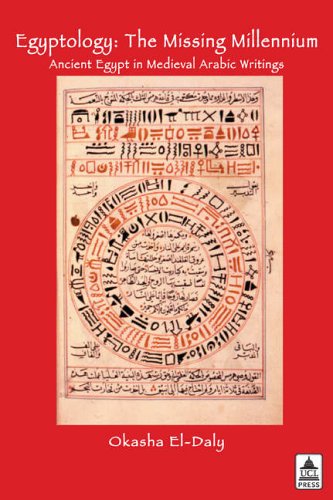
Cover of O. El Daly, Egyptology: The Missing Millennium. Ancient Egypt in Medieval Arabic Writings (London, 2005).
But in my own work as an Egyptologist, it became very clear, that Arabic groups were already well known in Ancient Egypt, and indeed this is clear from a group of pottery heads discovered during the excavation of Sir W. F. Petrie, who worked in Egypt from 1882 for almost all his life. In Memphis, one of the most ancient capitals of Egypt, he discovered what we call the Foreign Quarter, in which we have a number of people of Arabic origin who immigrated from as far as Yemen, Arabia and various other parts of the Arab World, into Ancient Egypt. Not only coming as immigrants and traders, but settling in Egypt in their own cities which were sometimes called “Com Arabus” in Greek, which means “The City of the Arabs”, and we have several of those documented already. More interesting from my point of view as an Egyptologist, is that we find them serving in the ancient Egyptian priesthood and Egyptian civil service with common Arabic names –such as Khalid and Abdul. It was fascinating to see it in the ancient Egyptian hieroglyphic texts. So, it is important to point out that Arabs existed already, and they were known, and they transferred some of what they have known from Ancient Egyptian culture to fellow Arabs elsewhere outside Egypt. And if you look at the map, you can see clearly how easy it was for Arabs to enter Egypt – if you look at the northern part of the map, they crossed from Arabia into Egypt through Sinai, and if you look at the bottom of the map, they crossed the Red Sea, then through the Eastern desert into the Nile Valley. Or perhaps through Bab El-Mandab into Ethiopia/Sudan and then from various parts of the coast and inland Africa down to Egypt which of course is part of Africa, but sadly, Egyptologists used to teach Egypt as if it was a European rather than an African culture for all sorts of reasons.
Now, when Muslims annexed Egypt in the 7th century (I say Muslims and not Arabs, because though Arabic was their language, they came from various lands beyond Arabia), they were encouraged by various Quranic verses to study the ancient civilisations and ponder their fate as well as the many Hadiths of the Prophet Muhammad in praise of Egypt and its people, they went everywhere visiting monuments, tombs, chapels, gathering all sort of knowledge and materials. When ancient buildings fell out of use, they sometimes built on top of them or inside them, following a Christian tradition which used some of these ancient Egyptian temples as Churches and so on. The Mosque of Abu Al-Hajjaj in Luxor, Upper Egypt, is a very good example of how they created for themselves a sacred place of worship on top of an ancient Egyptian temple. Now, scholars going to visit this Mosque or pray in it, were not going to fail to be impressed by the great architecture of ancient Egypt that surrounded their visit, and if you are a true scholar, you are going to be curious as to what these hieroglyphs on the walls would mean. There is a good reason why Arabic and Muslim scholars took such an interest in Hieroglyphics. It is because Egypt was already known since antiquity as the land of Science, and in particular the Science of Alchemy. In fact the word Alchemy is believed by many to be derived from the word Kemit, which is the ancient Egyptian name of Egypt. It is interesting that various Arabic scholars thought that by unlocking the secrets of Egyptian scripts, including Egyptian hieroglyphs, they were unlocking the gates to a great deal of scientific knowledge in Alchemy as well as in other fields. They would have visited the temples themselves, in fact we are told of so many Arabic scholars, Muslims and non-Muslims, seeking knowledge in Monasteries from the Egyptian Coptic monks, and also in temples which sometimes were preserved and used by Coptic monks.
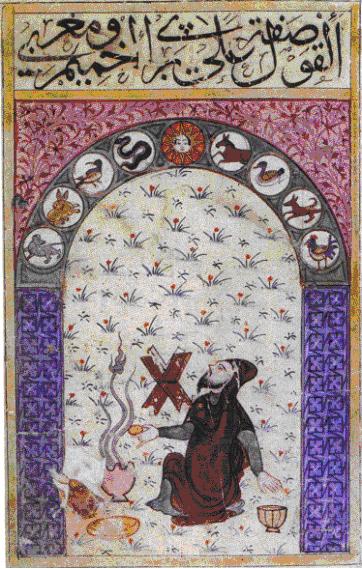
A medieval astrologer offering incense at the Temple of Akhmin (Arabic manuscript preserved at the Bodleian Library, MS Or 133, folio 29a). Source : El Daly 2005, figure 5.
The picture depicted in figure 3, extracted from an Arabic manuscript on astrology, probably shows a priest inside the Temple of Akhmim, one of the most important cities in Ancient Egypt that continued to serve as a great centre of learning well into the medieval period. One of the most important sources for the process of hieroglyphic decipherment, is the famous Sufi mystic Dhu Al-Nun Al-Misri, who lived inside that temple where he was brought up and it is said that he was fluent in the language of the walls of the temple i.e. hieroglyphs. This is just to show the interest of Arabic and Muslim scholars in these Egyptian temples and their reliefs and hieroglyphs. They used ancient Egyptian elements in building and sometimes decorating important parts of the mosques, yet there are still critics who say that Muslims did not like ancient monuments, and they used their stones as threshold at the entrance to mosques as a way of insulting and degrading ancient cultures showing the triumph of Islam over their monuments. Almost all the examples I know from Egypt serve as good examples to the opposite. We find beautiful ancient Egyptian blocks sometimes decorated with hieroglyphs, elevated to the top of the entrance of the mosque as a lintel, a remarkable eye-catching position. No Muslim going to pray will fail to notice these beautiful hieroglyphs on the top of the entrance of the mosque.

Symbols in medieval Arabic alchemy inspired by Egyptian hieroglyphs: Kitab al-Aqalim by Abu ‘l-Qasim al-‘Iraqi (British Library in London, MS Add 25724, folio 11a). Source : El Daly 2005, figure 12.
All these hieroglyphic inscriptions and ancient sites were incentive to some Muslims to spend a great deal of their time studying archaeological sites and writing about them. There is an early, if not the earliest, drawing of an archaeological site that I found in these sources. It shows the famous pyramid site of Al- Lahoon in middle Egypt. There is also the famous drawing of the ancient Light House of Alexandria by Abu Hamid Al-Gharnati. Sometimes a Muslim scholar was so impressed by an ancient Egyptian monument that he wrote a whole book on the subject, such as the great work of Abu Ja’far Al-Idrisi who died in 1251. He wrote a large volume on the great pyramids of Giza, and several books on the history of ancient Egypt as well.
Now, I mentioned Alchemy and Alchemists in particular who took great interest in Egyptian hieroglyphics and Egyptian sites, such as temples, tombs etc, because there they found very good sources for their Alchemical knowledge as we see from the work of Dhu Al-Nun Al-Misri, Ibn Wahishiya and Abu Al-Qasem Al-‘Iraqi. The latter is a 14th century scholar/alchemist, who came from Iraq and lived in Egypt. The important thing about his books is that they are full of ancient Egyptian signs and hieroglyphs like those which were perhaps used for their alchemical connection. It also contains another very important ancient Egyptian symbol called Oroboros, or the snake that eats its tail as a sign of eternity and regeneration, a very important ancient Egyptian symbol that becomes a very potent symbol in medieval alchemical Arabic/Muslim and Latin works with the very same meaning.
Arabic and Muslim artists made extensive use of hieroglyphs in their works in Egypt and elsewhere. Many hieroglyphic symbols have been used as decorative motifs in various ways and on different media.
Not only did they take an interest in ancient Egyptian materials, sciences and temples, they also went into Coptic Churches and Monasteries and noticed how they were decorated with beautiful Coptic. Sometimes they copied Coptic words as we can see in the book of Abu Al-Qasem Al-‘Iraqi where he copied an icon, and managed to correctly and beautifully copy the name of Michael and Gabriel, and anybody here who has studied Coptic will realize what beautiful handwriting in Coptic this is.
However, the topic of my talk is the decipherment process of ancient Egyptian scripts, particularly hieroglyphs. The very first scholar believed to have left a book, now missing, on the whole subject of decipherment, was named by later authors as Jabir Ibn Hayan, (8th century) the famous chemist who was said to have written an encyclopaedic work on the decipherment of many ancient scripts including Egyptian. The above mentioned Al-Idrisi mentioned an Egyptian scholar called Ayub Ibn Maslamah (9th century) as a fluent decipherer of hieroglyphs who wrote a book on how to read them. This is also missing. Almost a contemporary of his, was the Sufi mystic Dhu Al-Nun Al-Misri who was familiar not only with Egyptian hieroglyphs but religious practices as well which led him to create a new Sufi discipline known as ‘Ilm Al-Ahwal wa Al-Maqamat, based mainly on Egyptian spiritual and philosophical thoughts. Some of his works on the decipherment of ancient scripts survived and is yet to be studied in depth and published.
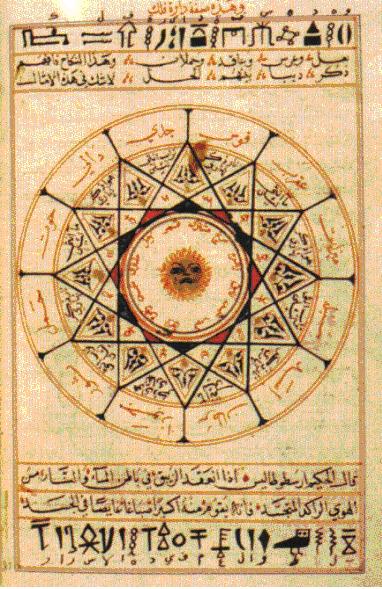
Another sample of alchemical symbols in Kitab al-Aqalim by Abu ‘l-Qasim al-‘Iraqi inspired by Egyptian hieroglyphs (British Library in London, MS Add 25724, folio 21b). Source : El Daly 2005, figure 21.
During the 10th century, we have the famous alchemist Ibn Wahishiya who came from Iraq and visited Egypt where he had discussions with other scholars in his field. Though there are some modern scholars who doubted his existence and regard him as a fictional character, his works on hieroglyphs were already cited and discussed by his contemporaries. His book on the decipherment of hieroglyphs among many other ancient scripts (more than 90) survived in probably a handful of copies worldwide, including the one in Paris which is used in my research. It shows that he reached the correct understanding that hieroglyphs are not really pictures or symbols, but they have phonetic value, i.e. some are letters of an alphabet of Egyptian language, but that had already been established years earlier by the scholars cited above. But Ibn Wahishiya distinguished himself by his success in understanding that some hieroglyphs were used not just for their phonetic value but as meaning signifiers or determinatives. These were signs/pictures which stand at the end of the word to define its exact meaning. Upon comparing a set of such signs in his work with our standard current works on Egyptian grammar, we can see that Ibn Wahishiya was correct in many of his identifications of Egyptian signs. He certainly knew what he was talking about. The importance of his work was already realised by A. Kircher, the first European scholar to write a book on Coptic grammar in the early 17 century, and two centuries later, his work was translated into English and published by Hammer in 1806 as mentioned above. And finally we have the work of the 14th century, again an alchemist from Iraq, Abu Al-Qasem Al-Iraqi. His books are full of correctly copied ancient Egyptian monuments with hieroglyphic texts, and we have also his table of Egyptian hieroglyphic alphabets with their phonetic values. Not all of his phonetic renderings are correct but the principle and several phonetic values are correct.
We have been told endlessly how Arabic/Muslim scholars preserved Greek sciences, and sometimes we are told how they improved and developed them. Some even think that Arabic/Muslim scholars were interested only in ‘useful sciences’ such as medicines, chemistry, and mechanics. But we are not told that they took a universal interest in ancient cultures, not only to benefit from their useful sciences, but also because they were genuinely interested in their overall cultures as can be seen from their interest in Ancient Egypt.
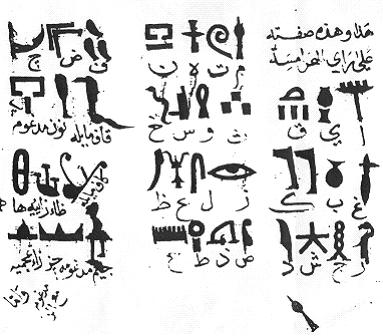
Egyptian alphabet according to Ibn Wahshiyya (Paris, Bibliothèque Nationale, MS Arabe 6805 folios 92b. ff).
One final point of great significance is the fact that early medieval Arabic/Muslim scholars realised the relationship between ancient Egyptian language which they sometimes called “The First Coptic” and the last phase of that language as spoken and used by their contemporary Egyptian Christians, and known as Coptic, which they called “The Second Coptic”. Indeed, Coptic is the last development of the ancient Egyptian language.
We owe a great deal in Egyptology to medieval Egyptian scholars who, fearing the lack of interest in learning Coptic on the part of the Christian Egyptian community, decided to write lessons on Coptic grammar in Arabic. Kircher, as mentioned above was able to produce the first Coptic grammar in Latin in the West, through his use of more than 40 Arabic books brought from Egypt and listed in his own books, which shows how grateful he was for his Arabic sources. So you can now see the debt we owe to these early Arabic books on Coptic grammar and their awareness of the relationship between the ancient Egyptian language and contemporary Coptic. Champollion built on all these Arabic sources and thus he arrived at a better understanding and decipherment of hieroglyphs, while equally competent European scholars working on the same question could not match his success because they lacked a knowledge of Arabic, a language Champollion mastered first before embarking on his quest. I would like to conclude with a remark that is closely connected with this Arabic/Muslim interest in Ancient Egypt.
Talking about preserving Ancient Egyptian knowledge, one finds that Muslims preserved for us not only copies of the monuments which otherwise have disappeared, but they also preserved for us Egyptian scientific knowledge that is missing from our current records, and is only known today from medieval Arabic and Muslim sources. The famous theory of evolution and the origin of species was already widely accredited by Arabic scholars to ancient Egyptian scientists and various medieval Arabic scholars actually discussed this in detail, and therefore when you study Darwin please do keep in mind that ancient Egyptians were perhaps the first to think of evolutionary theory and thanks to Arabic/Muslim scholars such knowledge is preserved for us. They did not just preserve this whole material, but had some of it deciphered correctly. They also studied and interpreted this ancient culture 1000 years or so before us. This Arabic Interpretation of Egyptian civilisation is not less valid than that of the Western one and in many ways it is as important. These Arabic/Muslim authors left for us a great deal more in terms of preserving Ancient Egypt and its knowledge as well as communicating this knowledge to others via translations. It is worth mentioning here that among the earliest Arabic translations commissioned by Khaled Ibn Yazid in the 7th century, were several books from Coptic. It is known that many ancient Egyptian books were translated into Greek and Coptic, two of the languages which many Arabic/Muslim scholars mastered. It is often forgotten that the true origin of much of the Greek knowledge is actually Egyptian, Mesopotamian and Persian, all of which were first translated into Greek then into Arabic.
I have limited myself here to the Arabic/Muslim contribution to the process of deciphering and unlocking the secrets of Egyptian hieroglyphs but from almost two decades of research it is clear that when we talk of the Western phenomena known as Egyptomania we should remember the earlier one which paved the road and which we can call “Arabic/Muslim Egyptomania”.
by: Dr. Okasha El Daly, Thu 12 July, 2007
For more details see
– Okasha El Daly, Egyptology: The Missing Millennium. Ancient Egypt in Medieval Arabic Writings. London: UCL Press, 2005.
– Arabic Study of Ancient Egypt: online at http://muslimheritage.com/topics/default.cfm?ArticleID=481.
* Dr. Okasha El Daly (PhD), is a Honorary Research Fellow, Institute of Archaeology, University College, London.
Further references
- Hieroglyphics cracked 1,000 years earlier than thought
- Arabic Study of Ancient Egypt
- Arab scholar ‘cracked Rosetta code’ 800 years before the West


